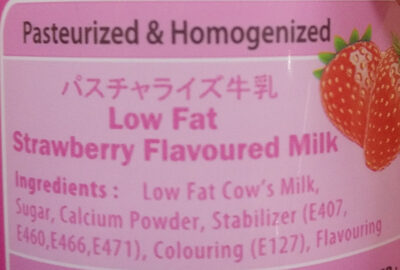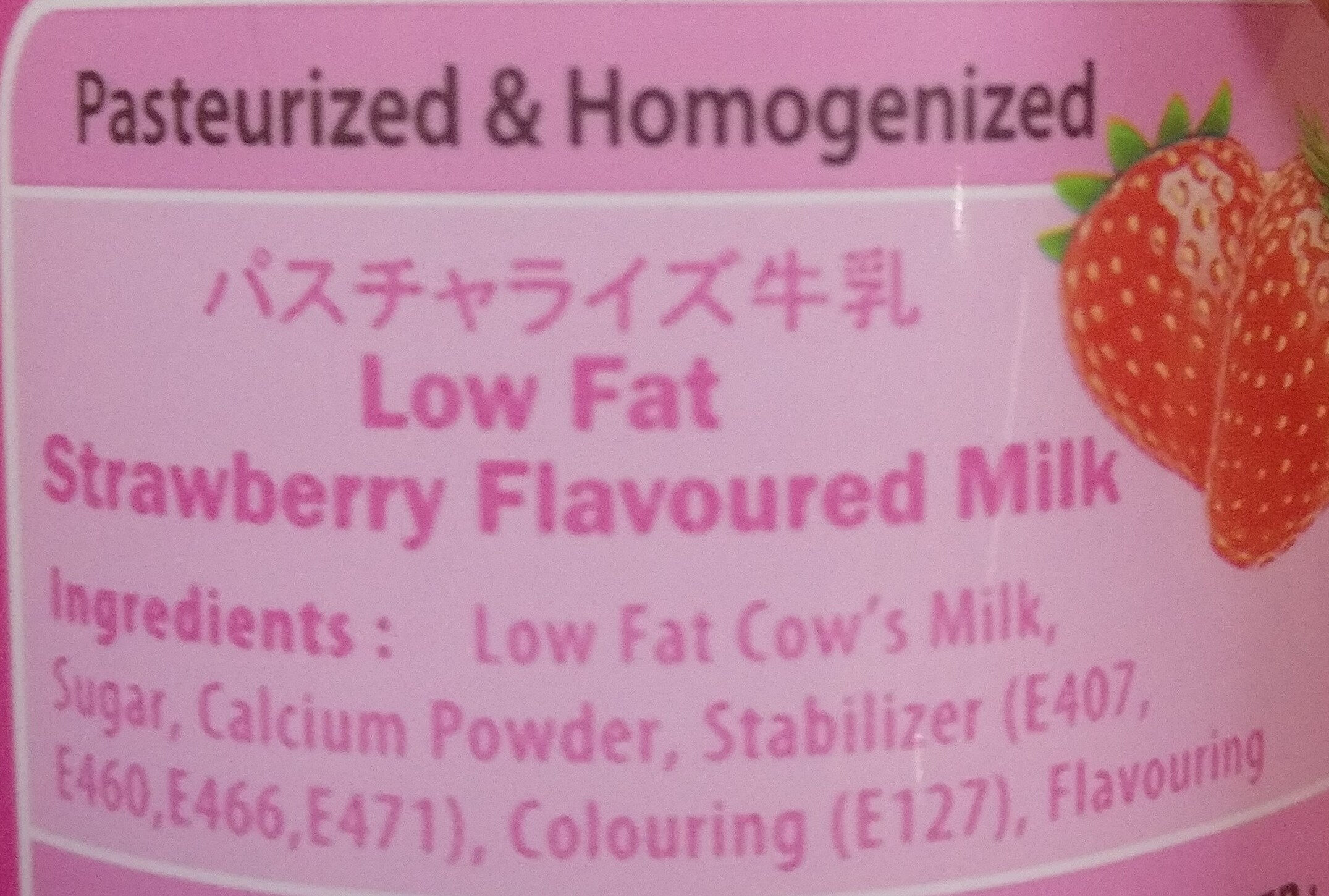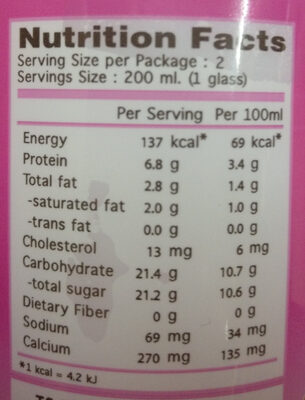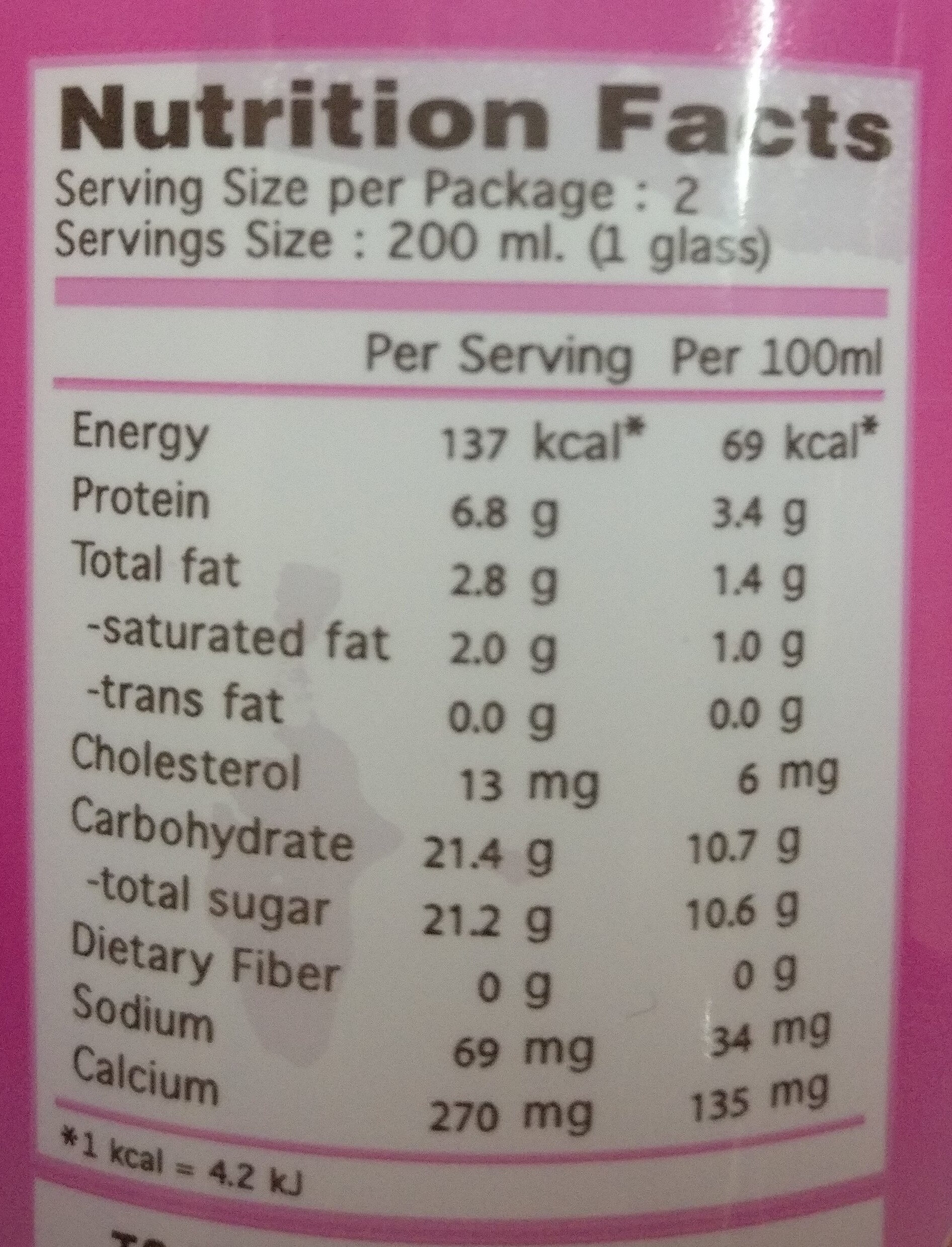Help us make food transparency the norm!
As a non-profit organization, we depend on your donations to continue informing consumers around the world about what they eat.
The food revolution starts with you!
Low Fat Strawberry Flavour Milk - Meiji - 450 ml
Low Fat Strawberry Flavour Milk - Meiji - 450 ml
This product page is not complete. You can help to complete it by editing it and adding more data from the photos we have, or by taking more photos using the app for Android or iPhone/iPad. Thank you!
×
Barcode: 8850329145614 (EAN / EAN-13)
Quantity: 450 ml
Packaging: Plastic bottle
Brands: Meiji
Categories: Beverages, Dairies, Dairy drinks, Flavoured milks, Strawberry milks
Labels, certifications, awards:
Halal, HACCP, Healthier Choice Singapore
Manufacturing or processing places: Thailand
Stores: 7-Eleven
Countries where sold: Singapore
Matching with your preferences
Health
Ingredients
-
11 ingredients
Low Fat Cow's Milk, Sugar, Calcium Powder, Stabilizer (E407, E460, E466, E471), Colouring (E127), Flavouring
Food processing
-
Ultra processed foods
Elements that indicate the product is in the 4 - Ultra processed food and drink products group:
- Additive: E127 - Erythrosine
- Additive: E407 - Carrageenan
- Additive: E460 - Cellulose
- Additive: E466 - Sodium carboxy methyl cellulose
- Additive: E471 - Mono- and diglycerides of fatty acids
- Ingredient: Colour
- Ingredient: Flavouring
Food products are classified into 4 groups according to their degree of processing:
- Unprocessed or minimally processed foods
- Processed culinary ingredients
- Processed foods
- Ultra processed foods
The determination of the group is based on the category of the product and on the ingredients it contains.
Additives
-
E127 - Erythrosine
Erythrosine: Erythrosine, also known as Red No. 3, is an organoiodine compound, specifically a derivative of fluorone. It is cherry-pink synthetic, primarily used for food coloring. It is the disodium salt of 2‚4,5‚7-tetraiodofluorescein. Its maximum absorbance is at 530 nm in an aqueous solution, and it is subject to photodegradation.Source: Wikipedia
-
E407 - Carrageenan
Carrageenan (E407), derived from red seaweed, is widely employed in the food industry as a gelling, thickening, and stabilizing agent, notably in dairy and meat products.
It can exist in various forms, each imparting distinct textural properties to food.
However, its degraded form, often referred to as poligeenan, has raised health concerns due to its potential inflammatory effects and its classification as a possible human carcinogen (Group 2B) by the International Agency for Research on Cancer (IARC).
Nevertheless, food-grade carrageenan has been deemed safe by various regulatory bodies when consumed in amounts typically found in food.
-
E460 - Cellulose
Cellulose: Cellulose is an organic compound with the formula -C6H10O5-n, a polysaccharide consisting of a linear chain of several hundred to many thousands of β-1→4- linked D-glucose units. Cellulose is an important structural component of the primary cell wall of green plants, many forms of algae and the oomycetes. Some species of bacteria secrete it to form biofilms. Cellulose is the most abundant organic polymer on Earth. The cellulose content of cotton fiber is 90%, that of wood is 40–50%, and that of dried hemp is approximately 57%.Cellulose is mainly used to produce paperboard and paper. Smaller quantities are converted into a wide variety of derivative products such as cellophane and rayon. Conversion of cellulose from energy crops into biofuels such as cellulosic ethanol is under development as a renewable fuel source. Cellulose for industrial use is mainly obtained from wood pulp and cotton.Some animals, particularly ruminants and termites, can digest cellulose with the help of symbiotic micro-organisms that live in their guts, such as Trichonympha. In human nutrition, cellulose is a non-digestible constituent of insoluble dietary fiber, acting as a hydrophilic bulking agent for feces and potentially aiding in defecation.Source: Wikipedia
-
E466 - Sodium carboxy methyl cellulose
Carboxymethyl cellulose: Carboxymethyl cellulose -CMC- or cellulose gum or tylose powder is a cellulose derivative with carboxymethyl groups --CH2-COOH- bound to some of the hydroxyl groups of the glucopyranose monomers that make up the cellulose backbone. It is often used as its sodium salt, sodium carboxymethyl cellulose.Source: Wikipedia
-
E471 - Mono- and diglycerides of fatty acids
Mono- and diglycerides of fatty acids (E471), are food additives commonly used as emulsifiers in various processed foods.
These compounds consist of glycerol molecules linked to one or two fatty acid chains, which help stabilize and blend water and oil-based ingredients. E471 enhances the texture and shelf life of products like margarine, baked goods, and ice cream, ensuring a smooth and consistent texture.
It is generally considered safe for consumption within established regulatory limits.
Ingredients analysis
-
May contain palm oil
Ingredients that may contain palm oil: E471
-
Vegan status unknown
Unrecognized ingredients: Low-fat-cow-s-milk, CalciumSome ingredients could not be recognized.
We need your help!
You can help us recognize more ingredients and better analyze the list of ingredients for this product and others:
- Edit this product page to correct spelling mistakes in the ingredients list, and/or to remove ingredients in other languages and sentences that are not related to the ingredients.
- Add new entries, synonyms or translations to our multilingual lists of ingredients, ingredient processing methods, and labels.
If you would like to help, join the #ingredients channel on our Slack discussion space and/or learn about ingredients analysis on our wiki. Thank you!
-
Vegetarian status unknown
Unrecognized ingredients: Low-fat-cow-s-milk, CalciumSome ingredients could not be recognized.
We need your help!
You can help us recognize more ingredients and better analyze the list of ingredients for this product and others:
- Edit this product page to correct spelling mistakes in the ingredients list, and/or to remove ingredients in other languages and sentences that are not related to the ingredients.
- Add new entries, synonyms or translations to our multilingual lists of ingredients, ingredient processing methods, and labels.
If you would like to help, join the #ingredients channel on our Slack discussion space and/or learn about ingredients analysis on our wiki. Thank you!
-
Details of the analysis of the ingredients
We need your help!
Some ingredients could not be recognized.
We need your help!
You can help us recognize more ingredients and better analyze the list of ingredients for this product and others:
- Edit this product page to correct spelling mistakes in the ingredients list, and/or to remove ingredients in other languages and sentences that are not related to the ingredients.
- Add new entries, synonyms or translations to our multilingual lists of ingredients, ingredient processing methods, and labels.
If you would like to help, join the #ingredients channel on our Slack discussion space and/or learn about ingredients analysis on our wiki. Thank you!
: Low Fat Cow's Milk, Sugar, Calcium, Stabilizer (e407, e460, e466, e471), Colouring (e127), Flavouring- Low Fat Cow's Milk -> en:low-fat-cow-s-milk - percent_min: 52.6 - percent_max: 100
- Sugar -> en:sugar - vegan: yes - vegetarian: yes - ciqual_proxy_food_code: 31016 - percent_min: 0 - percent_max: 10.6
- Calcium -> en:calcium - percent_min: 0 - percent_max: 10.6
- Stabilizer -> en:stabiliser - percent_min: 0 - percent_max: 10.6
- e407 -> en:e407 - vegan: yes - vegetarian: yes - percent_min: 0 - percent_max: 10.6
- e460 -> en:e460 - vegan: yes - vegetarian: yes - percent_min: 0 - percent_max: 5.3
- e466 -> en:e466 - vegan: yes - vegetarian: yes - percent_min: 0 - percent_max: 3.53333333333333
- e471 -> en:e471 - vegan: maybe - vegetarian: maybe - from_palm_oil: maybe - percent_min: 0 - percent_max: 2.65
- Colouring -> en:colour - percent_min: 0 - percent_max: 10.6
- e127 -> en:e127 - vegan: yes - vegetarian: yes - percent_min: 0 - percent_max: 10.6
- Flavouring -> en:flavouring - vegan: maybe - vegetarian: maybe - percent_min: 0 - percent_max: 5
Nutrition
-
Bad nutritional quality
⚠ ️Warning: the amount of fruits, vegetables and nuts is not specified on the label, it was estimated from the list of ingredients: 0This product is considered a beverage for the calculation of the Nutri-Score.
Positive points: 0
- Proteins: 2 / 5 (value: 3.4, rounded value: 3.4)
- Fiber: 0 / 5 (value: 0, rounded value: 0)
- Fruits, vegetables, nuts, and colza/walnut/olive oils: 0 / 10 (value: 0, rounded value: 0)
Negative points: 18
- Energy: 10 / 10 (value: 289, rounded value: 289)
- Sugars: 8 / 10 (value: 10.6, rounded value: 10.6)
- Saturated fat: 0 / 10 (value: 1, rounded value: 1)
- Sodium: 0 / 10 (value: 34.544, rounded value: 34.5)
The points for proteins are not counted because the negative points are greater or equal to 11.
Nutritional score: (18 - 0)
Nutri-Score:
-
Nutrient levels
-
Fat in low quantity (1.4%)
What you need to know- A high consumption of fat, especially saturated fats, can raise cholesterol, which increases the risk of heart diseases.
Recommendation: Limit the consumption of fat and saturated fat- Choose products with lower fat and saturated fat content.
-
Saturated fat in moderate quantity (1%)
What you need to know- A high consumption of fat, especially saturated fats, can raise cholesterol, which increases the risk of heart diseases.
Recommendation: Limit the consumption of fat and saturated fat- Choose products with lower fat and saturated fat content.
-
Sugars in high quantity (10.6%)
What you need to know- A high consumption of sugar can cause weight gain and tooth decay. It also augments the risk of type 2 diabetes and cardio-vascular diseases.
Recommendation: Limit the consumption of sugar and sugary drinks- Sugary drinks (such as sodas, fruit beverages, and fruit juices and nectars) should be limited as much as possible (no more than 1 glass a day).
- Choose products with lower sugar content and reduce the consumption of products with added sugars.
-
Salt in low quantity (0.0864%)
What you need to know- A high consumption of salt (or sodium) can cause raised blood pressure, which can increase the risk of heart disease and stroke.
- Many people who have high blood pressure do not know it, as there are often no symptoms.
- Most people consume too much salt (on average 9 to 12 grams per day), around twice the recommended maximum level of intake.
Recommendation: Limit the consumption of salt and salted food- Reduce the quantity of salt used when cooking, and don't salt again at the table.
- Limit the consumption of salty snacks and choose products with lower salt content.
-
-
Nutrition facts
Nutrition facts As sold
for 100 g / 100 mlAs sold
per serving (200ml)Compared to: Strawberry milks Energy 289 kj
(69 kcal)578 kj
(138 kcal)-5% Fat 1.4 g 2.8 g -21% Saturated fat 1 g 2 g -2% Trans fat 0 g 0 g -100% Cholesterol 6 mg 12 mg -17% Carbohydrates 10.7 g 21.4 g - Sugars 10.6 g 21.2 g +7% Fiber 0 g 0 g -100% Proteins 3.4 g 6.8 g +7% Salt 0.086 g 0.173 g -31% Calcium 135 mg 270 mg +9% Fruits‚ vegetables‚ nuts and rapeseed‚ walnut and olive oils (estimate from ingredients list analysis) 0 % 0 %
Environment
-
Eco-Score D - High environmental impact
⚠ ️Select a country in order to include the full impact of transportation.The Eco-Score is an experimental score that summarizes the environmental impacts of food products.→ The Eco-Score was initially developped for France and it is being extended to other European countries. The Eco-Score formula is subject to change as it is regularly improved to make it more precise and better suited to each country.Life cycle analysis
-
Average impact of products of the same category: C (Score: 49/100)
Category: Strawberry flavoured milk, with sugar, partially skimmed, fortified with vitamins D
Category: Strawberry flavoured milk, with sugar, partially skimmed, fortified with vitamins D
- PEF environmental score: 0.16 (the lower the score, the lower the impact)
- including impact on climate change: 1.38 kg CO2 eq/kg of product
Stage Impact Agriculture
56.9 %Processing
0.9 %Packaging
24.9 %Transportation
10.1 %Distribution
5.7 %Consumption
1.6 %
Bonuses and maluses
-
Missing origins of ingredients information
Malus: -5
⚠ ️ The origins of the ingredients of this product are not indicated.
If they are indicated on the packaging, you can modify the product sheet and add them.
If you are the manufacturer of this product, you can send us the information with our free platform for producers.
-
Packaging with a medium impact
Malus: -10
Shape Material Recycling Impact Bottle Plastic High
Eco-Score for this product
-
Impact for this product: D (Score: 34/100)
Product: Low Fat Strawberry Flavour Milk - Meiji - 450 ml
Life cycle analysis score: 49
Sum of bonuses and maluses: -15
Final score: 34/100
-
Carbon footprint
-
Equal to driving 0.7 km in a petrol car
138 g CO² per 100g of product
The carbon emission figure comes from ADEME's Agribalyse database, for the category: Strawberry flavoured milk, with sugar, partially skimmed, fortified with vitamins D (Source: ADEME Agribalyse Database)
Stage Impact Agriculture
68.6 %Processing
0.8 %Packaging
12.9 %Transportation
14.7 %Distribution
2.6 %Consumption
0.5 %
Packaging
-
Packaging with a medium impact
-
Packaging parts
Bottle (Plastic)
-
Packaging materials
Material % Packaging weight Packaging weight per 100 g of product Plastic
-
Transportation
-
Origins of ingredients
Missing origins of ingredients information
⚠ ️ The origins of the ingredients of this product are not indicated.
If they are indicated on the packaging, you can modify the product sheet and add them.
If you are the manufacturer of this product, you can send us the information with our free platform for producers.Add the origins of ingredients for this product Add the origins of ingredients for this product
Report a problem
-
Incomplete or incorrect information?
Category, labels, ingredients, allergens, nutritional information, photos etc.
If the information does not match the information on the packaging, please complete or correct it. Open Food Facts is a collaborative database, and every contribution is useful for all.
Data sources
Product added on by bcd4e6
Last edit of product page on by packbot.
Product page also edited by openfoodfacts-contributors.











